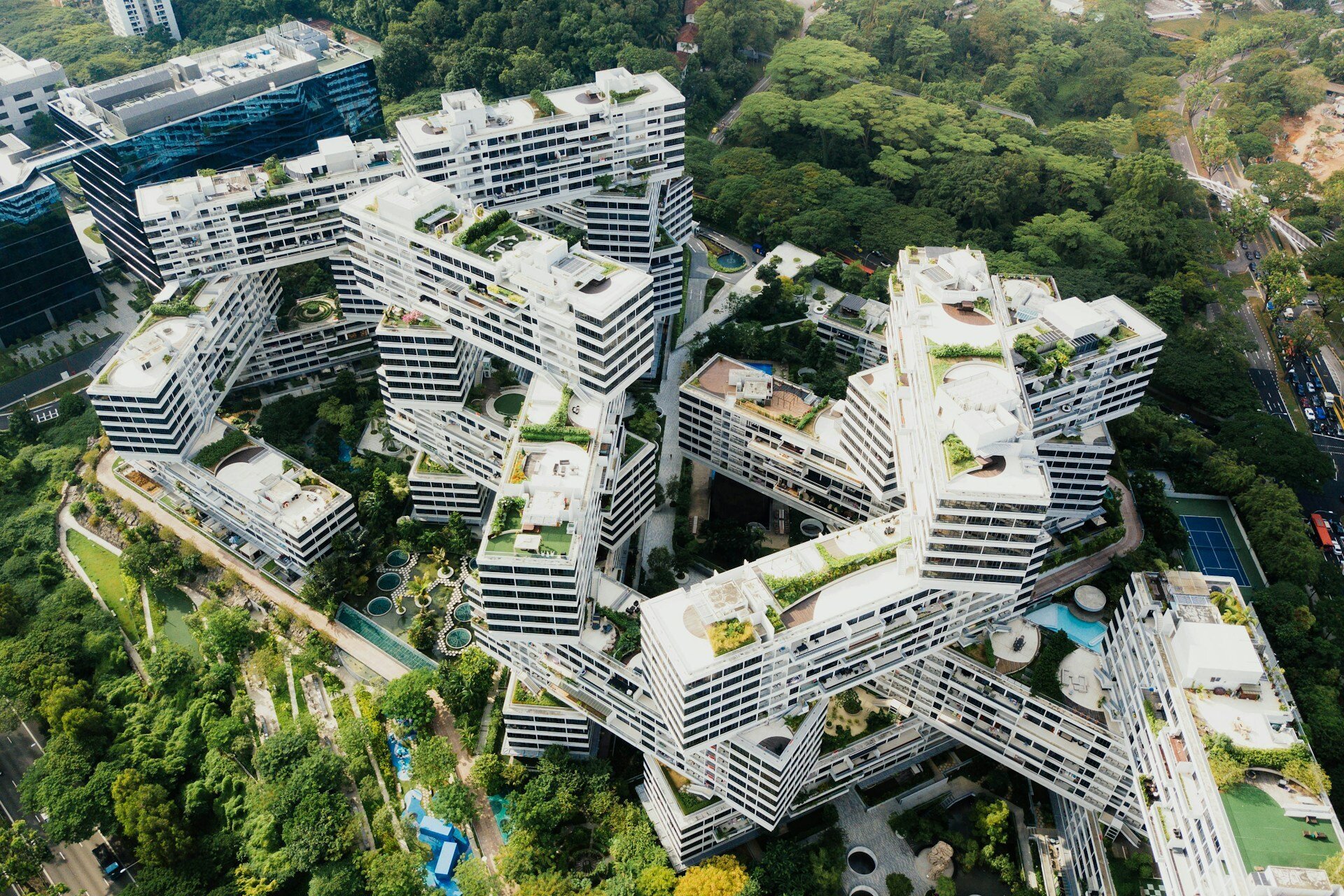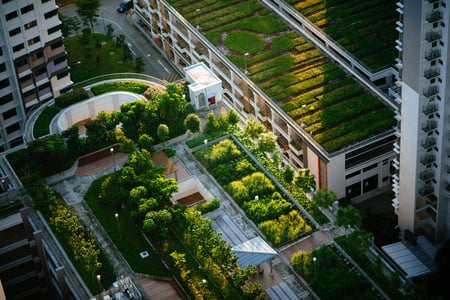How Green Roofs are Transforming Urban Landscapes and Communities
May , 2024 | 9 min. read

The skyline of a modern city is often dominated by towering buildings, and concrete jungles that reflect human ingenuity, and architectural prowess. But a new trend is sprouting up in cities worldwide, quite literally.
At RoofCrafters, we’re happy to share that green roofs, once a novel concept, are now blossoming into a mainstream solution, transforming urban landscapes and communities in ways that are both surprising and delightful.
So, if you’ve ever wondered what it would look like if we went back to the basics just a teensy bit, and brought back nature to the big city, you’re in the right place! In just a moment, you’ll learn what exactly green roofing is, as well as its benefits and drawbacks! Let’s get started.
What Exactly is a Green Roof?

A green roof, or living roof, is essentially a roof of a building that is partially or completely covered with vegetation and a growing medium, planted over a waterproofing membrane. It may also include additional layers such as a root barrier and drainage and irrigation systems.
These eco-friendly roofs can range from simple setups with a few inches of soil and hardy succulents to elaborate rooftop gardens featuring shrubs, trees, and even small ponds! The adoption of green roofs has been skyrocketing, particularly in dense urban environments where every square foot counts.
Environmental Benefits: More Than Just a Pretty Face

Green roofs are more than just visually appealing. They provide a multitude of environmental benefits that contribute to the health and sustainability of urban areas.
1. Urban Heat Island Effect Mitigation
One of the most significant advantages of green roofs is their ability to combat the urban heat island effect. Urban areas are typically warmer than their rural counterparts due to human activities and the prevalence of heat-absorbing materials like asphalt and concrete. Green roofs help counteract this by providing shade and through the process of evapotranspiration, where plants release water vapor into the air, cooling it down. This natural air conditioning can significantly lower ambient temperatures, making cities more comfortable during hot summer months.
2. Stormwater Management
Heavy rainfall can overwhelm urban drainage systems, leading to flooding and water pollution. Green roofs act as natural sponges, absorbing rainwater and releasing it slowly over time. This not only reduces the burden on drainage systems but also filters pollutants from the water, improving its quality before it reaches waterways.
3. Biodiversity Enhancement
Green roofs can serve as urban oases for various species of plants, birds, and insects. By providing habitats in the sky, they help support urban biodiversity. Some cities have even tailored their green roof programs to create specific habitats for endangered species, contributing to conservation efforts.
Social and Community Benefits: Greening the Human Spirit

Beyond their environmental impact, green roofs offer significant social and community benefits. They have the power to transform urban life, providing spaces for recreation, relaxation, and community building.
1. Enhanced Aesthetics and Mental Health
There's no denying that greenery makes a city more attractive. Green roofs introduce nature into urban settings, offering visual relief from the monotony of concrete and steel. Studies have shown that exposure to green spaces can reduce stress, improve mood, and enhance overall mental health. In cities where personal outdoor space is a luxury, green roofs provide accessible retreats that can significantly improve residents' quality of life.
2. Community Engagement
Green roofs often become communal spaces where residents can gather, interact, and engage in activities like gardening or social events. These shared spaces foster a sense of community and belonging, which is crucial for social cohesion in densely populated urban areas. For example, in some neighborhoods, rooftop gardens have become community hubs where people of all ages come together, fostering relationships and a sense of collective stewardship.
3. Food Production and Urban Agriculture
In many cities, green roofs are being used to grow food. Rooftop farms and gardens can produce fresh, local produce, reducing the need for long-distance transportation and the associated carbon footprint. These urban agriculture projects not only provide fresh food but also educate communities about sustainable practices and healthy eating.
Economic Benefits: A Win for Wallets

While the initial installation of green roofs can be costly, they offer long-term economic benefits that can outweigh the upfront expenses.
1. Energy Efficiency
Green roofs provide excellent insulation, helping to regulate building temperatures. In the summer, they keep buildings cooler, reducing the need for air conditioning. In the winter, they help retain heat, cutting down on heating costs. This improved energy efficiency translates into significant savings on energy bills over time.
2. Longevity of Roofing Materials
Traditional roofs are exposed to the elements, which can lead to wear and tear. Green roofs protect the underlying roof structure from UV rays, extreme temperatures, and mechanical damage, thereby extending the lifespan of the roofing materials. This means fewer replacements and repairs, resulting in long-term cost savings.
3. Increased Property Value
Buildings with green roofs are often more attractive to buyers and tenants, who appreciate the environmental benefits and aesthetic appeal. As a result, properties with green roofs can command higher prices and rental rates, making them a smart investment for property owners.
Challenges and Considerations

Despite the numerous benefits, green roofs are not without their challenges. Proper planning, installation, and maintenance are crucial for their success.
1. Structural Requirements
Not all buildings can support the additional weight of a green roof. Structural assessments are necessary to determine if a building can handle the load of soil, plants, and water. Reinforcements may be needed, adding to the initial cost.
2. Maintenance
Green roofs require regular maintenance to ensure the health of the plants and the integrity of the roofing system. This includes watering, weeding, and occasional replanting. While some green roofs are designed to be low-maintenance, others, especially intensive green roofs with diverse plant species, can be labor-intensive.
3. Initial Costs
The upfront costs of installing a green roof can be significant, encompassing design, materials, and labor. However, many cities offer incentives and grants to offset these costs, recognizing the long-term benefits.
A Greener Future
The future of green roofs looks promising as technology and techniques continue to evolve. Innovations such as modular green roof systems, which make installation easier and more affordable, are gaining popularity. Additionally, advancements in plant selection and soil substrates are improving the efficiency and resilience of green roofs.
As cities grapple with climate change, urbanization, and the need for sustainable development, green roofs offer a multifaceted solution that addresses environmental, social, and economic challenges. They represent a shift towards more harmonious urban living, where nature and human habitation coexist and thrive.
All in all, green roofs are transforming urban landscapes and communities in profound ways. They are more than just a trend; they are a testament to human ingenuity and our ability to adapt and innovate for a greener, healthier, and more sustainable future. So next time you look up at a city's skyline, imagine a world where every rooftop is a lush, green oasis, which is a vision that is increasingly becoming a reality.
My name is Cassie, and I’m the Content Manager here at RoofCrafters. I was born and raised in Chicago, Illinois, and made my way out to Florida post-college graduation. I’m incredibly passionate about writing and creating valuable content that helps others with the collaboration of my marketing team. When I’m not working, I enjoy shopping (a little too much), spending time at the beach, and reading!



